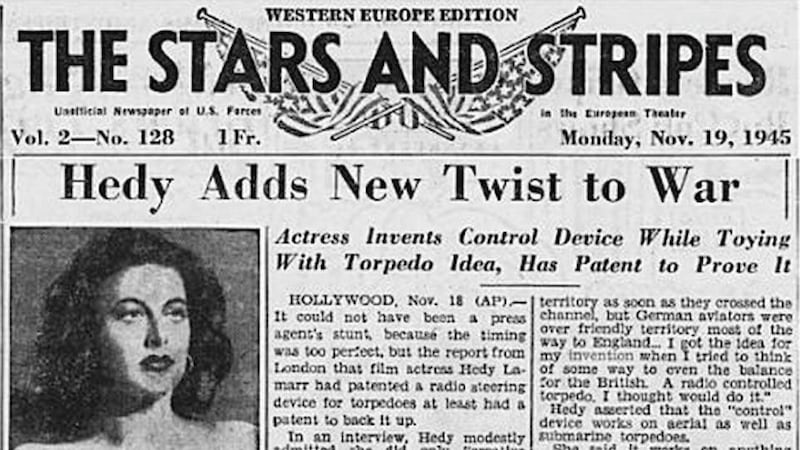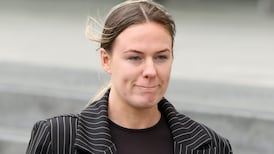In the 1940s, Hedy Lamarr was widely regarded as “the most beautiful woman in the world”. And she couldn’t have cared less. “Any girl can be glamorous,” she once witheringly observed. “All you have to do is stand still and look stupid.”
Bombshell: The Hedy Lamarr Story, a new documentary from director Alexandra Dean and executive producer Susan Sarandon, shows how difficult it was for Lamarr to be considered as more than a pretty face.
Before becoming involved with the film, all Sarandon knew of Lamarr was “that she was unimaginably beautiful, swam naked in a film and was rumoured to have invented something”.
It wasn’t just something.
The Viennese golden era Hollywood star – born Hedy Kiesler in Austria and renamed by studio head Louis B Mayer – was fascinated by science and mathematics since childhood.
At the height of her fame, she developed an improved stoplight, a skin-tautening technique, and a tablet that, when dissolved in water, turned into cola.
In 1942, Lamarr and her business partner, the avant-garde composer George Antheil, received a US patent for a frequency-hopping device designed to guide radio-controlled torpedoes. Lamarr had realised that by transmitting radio signals along rapidly changing frequencies, it would be more difficult for German U-Boats to detect American radio-guided weapons in the water.
The US Navy tucked the patent away and suggested that Lamarr might be more usefully employed selling war bonds or appearing for the troops, with a note that read: “We won’t be needing your services here in Washington.”
That wasn’t entirely true. Lamarr’s frequency-hopping design relied on electronics that didn’t exist in the 1940s, but in 1962, three years after her patent expired, a refined version of her device was used by US Navy ships during the Cuban missile crisis.

Her frequency-hopping technique would ultimately inspire contemporary spread-spectrum communications, which has applications in encryption, satellite systems, GPS, bluetooth and mobile phone technologies. She was in her 80s and at the end of her life when one of the pioneers of wifi, upon realising that Lamarr had never been recognised for her contribution to communications, called her up. “Well, it’s about time,” came the response.
Erasure
As Bombshell director Alexandra Dean discovered, Lamarr's erasure didn't happen by accident. Several historians and scientists simply refused to accept that Lamarr might have been responsible for the frequency-hopping idea. Perhaps, they suggested, she stole her extraordinary invention from the engineers employed by her first husband, Fritz Mandl, who manufactured torpedoes for Hitler and Mussolini.
Historically, however, there are no references to frequency-hopping before her notebooks from the early 1940s.
“There was a moment in 1983 when Robert Price – who was the historian of digital communications – might have believed her story,” notes Dean. “If he had, I believe the story could have crossed over to the mainstream while she was still alive. He asked her: did you do this or was it really more George or was it something you’d seen in your husband’s manufacturing plant? And she said no, it was me. And he writes it, but he erases it. I looked at his notes. That line disappears. He intentionally changed the narrative. It was pure personal bias. She was too beautiful and not educated enough for people’s liking, and she was female. It’s amazing. When I started to work on this film there was about a 50-50 split between people who believed she actually did it and people who believed she stole the idea.”
Simulated orgasm
Even without her scientific achievements, Hedy Lamarr makes for a fascinating documentary subject. Hedwig Eva Maria Kiesler, the daughter of Viennese Jewish intellectuals, was still a teenager when she starred in Ecstasy (1932). Her performance may mark the first simulated orgasm to receive a widespread theatrical release, and the film was denounced by both the pope and by Adolf Hitler.
“The psychological trauma of having been signalled out by Hitler as a Jewish actress was extremely profound,” says Dean. “And I think she developed a kind of psychological amputation. I think that was her coping mechanism. I don’t think it was a good one. I don’t think anyone would recommend it.”
That trauma, and the loss of her former community in the Holocaust, may well have been a factor in her six failed marriages. There was damage, too, from years of prescription pills while she was employed within the studio system.
Her later years were overshadowed by shoplifting charges (for stealing $21.48 worth of laxatives and eye drops), poverty and botched plastic surgery. A career defined by bad girls and other women roles reached an unfortunate apotheosis in White Cargo, a huge hit for MGM in which she delivered the memorably awful line: "I am Tondelayo. I make tiffin for you?"
She was a scientist who wasn't taken seriously because she was so beautiful, challenging the traditional thinking that beauty and brains can't coexist
Her stuttering, low-brow film career was compounded by a sensational ghostwritten 1966 memoir, Ecstasy and Me: My Life as a Woman.
Dean was dismayed to learn that the recordings pertaining to that book and Lamarr’s subsequent legal action against the publisher were all lost.
“That was a big blow,” says Dean. “Perhaps I was naive but I felt sure there had to be a way for her to be in the film, that there must be recordings out there. We started contacting anyone that might have anything. Old journals or documents. We would have taken anything. We had a list of about 76 people that were still alive that might have something. We got to Fleming Meeks and he called right back and said: ‘I’ve been waiting 25 years for you to call me.’”
Hours of material
Meeks had four tapes from an interview he had conducted with Lamarr in 1990 for Forbes magazine. There was hours of material.
“As it turned out, you have to bake them in an oven to keep the sound attached,” explains Dean. “But three were usable. You could tantalisingly hear her say things like Spencer Tracy or Jimmy Stewart, but we couldn’t retrieve the rest. But that’s when we decided we had a film.”
It's only fitting that in Bombshell, Lamarr, through these 28-year-old recordings, finally gets to tell her own story. The new film arrives at the end of a decade when the Hedy Lamarr industry is in full swing. Since the turn of the millennium, there have been multiple biographies (including Stephen Michael Shearer's Beautiful and Richard Rhodes's Hedy's Folly), fantastic tabloid rumours about a threesome with Hitler, and a 2008 play, Frequency Hopping, by writer-director Elyse Singer.
Susan Sarandon thinks she knows why Lamarr’s time has come.
“She was a scientist who wasn’t taken seriously because she was so beautiful, challenging the traditional thinking that beauty and brains can’t coexist,” says Sarandon. “Time’s up on that notion. It’s time to encourage our young girls to open their minds and follow their passions into science, coding, entrepreneurship and inventing. We need the female contribution in our world now, more than ever.”
To mark International Women's Day, there will be a screening of Bombshell: The Hedy Lamarr Story, followed by a Q&A with director Alexandra Dean and executive producer Susan Sarandon broadcast live to cinemas from the BFI at 6.30pm





















